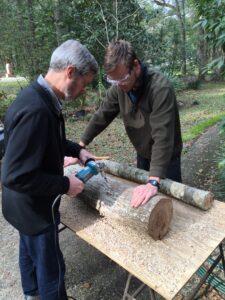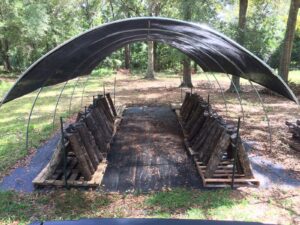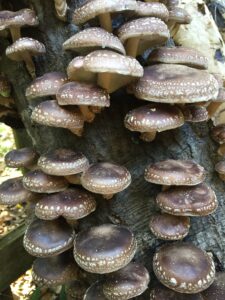2016 Annual Report for OS14-086
Use of non-native invasive tree logs for commercial mushroom production on small farms
Summary
Our project demonstrates the viability of logs from invasive trees to produce shiitake mushrooms on small farms in North Florida and South Georgia. This year, two farms successfully produced shiitake mushrooms on both Chinese tallow and oak logs. Yield varied by farm, mushroom strain, and log species. No mushrooms of either strain were produced on Chinaberry or mimosa logs.
Objectives/Performance Targets
Removal of invasive species, especially trees, is often time consuming and expensive. Even for a private landowner or small farmer, the cost of cutting down invasive trees and removing the waste generated by branches and trunks consumes resources in time, effort, personnel, and finances; negatively impacting farm sustainability. In an effort to help offset some of these expenditures for small farmers, our overall objective is to evaluate the potential of using non-native tree logs, common to the southern region, to produce edible and marketable mushrooms. We propose to turn unsustainable, non-native tree species into a sustainable, small farm commodity. Three invasive species are targeted in this study: Chinese tallowtree (Triadica sebifera), mimosa tree (Albizia julibrissin) and Chinaberry tree (Melia azedarach).
This two year study addresses three objectives:
1) Determine the yield of edible mushrooms (shiitake) on logs of four tree species common in the southeastern US (three non-native invasive species and native oak species);
2) Determine the economic profitability for small farmers in marketing edible mushrooms;
3) Provide hands-on training to farmers on growing mushrooms on invasive tree species.
Our initial Objective 1 submitted with the grant request was to evaluate the yield of two commercially grown fungi species; golden oyster (Pleurotus cornucopiae) and shiitake (Lentinula edodes). Because data collected from a pilot study initiated in 2014 identified poor production on oak from the golden oyster fungi, a second strain of shiitake was substituted for the golden oyster. Logs of all test tree species were inoculated with one of two shiitake varieties, Wide Range (WR) 46TM or Snow CapTM (Table 1).
Objective 2 economic data relating to the sale of mushrooms was collected by the farmers, but the analysis was not completed. Farmers sold shiitake mushrooms at several Farmer’s Markets, to Community Sustainable Agriculture (CSA) members, small local food stores, and at road-side stands.
Initial efforts on the third objective included the training of two farms in shiitake production on logs, establishment of mushroom production shade houses, and posting of photos and short videos on farmer websites of the project to produce edible mushrooms on non-native tree logs.
Accomplishments/Milestones
Each farm received 80 logs, divided into eight treatments (10 logs/farm/tree species/shiitake strain) (Table 1). Logs were three feet long and stacked on pallets under shady conditions for two weeks. Tree species harvested were Chinese tallow, Chinaberry, mimosa, and oak (random mixture of water oak, Quercus nigra, and laurel oak, Q. laurifolia). Logs were tagged, inoculated with one of two shiitake strains, and restacked on pallets under shade and irrigation. The target number of inoculation holes for each log was based on the log diameter relative to the “standard” 6 inch diameter log (Table 2). Twenty logs of each of the four tree species were managed at two farms; Full Earth Farm, Quincy, FL, and Little Eden Heirloom Farm, Crawfordsville, FL. All logs of Chinaberry and mimosa failed to produce shiitake mushrooms and appear to be unsuitable for shiitake mushroom production. Both shiitake strains were productive on Chinese tallow and oak at both farms (Tables 3 & 4).
Preliminary data of edible mushroom production on oak logs inoculated with shiitake strain WR-46 generally produced higher mushroom weights and number of mushrooms per log than the Snow Cap strain at both farms (Tables 3 & 4). Oak logs at Little Eden produced larger weights and numbers of mushrooms per log by strain than the tallow logs (Table 4). At Full Earth (Table 3), the weight and number of mushrooms per log by strain was larger on Oak with Snow Cap, but the number of mushrooms per log with WR-46 was larger on tallow than Oak. Also, while the weight per mushroom was greatest at Full Earth on oak with WR-46 and tallow with Snow Cap, the weight per mushroom at Little Eden was slightly reversed; greater on oak with Snow Cap and greater on tallow with WR-46. However, the high amount of variation in mushroom weights and numbers make the statistical differences non-significant. Additional first-year mushroom production will continue in March and April, and perhaps differences between strains will become noticeable.
2015
March: Trees were felled, cut to length (3 feet), inoculated with shiitake plug mycelium (Fig. 1), and stacked in the shade on pallets.
March-October: Logs were irrigated as needed to prevent drying. Market outlets for mushroom sales were identified (farmers/food markets, CSA’s, roadside stands, gourmet restaurants).
May: A shade cloth, hoop house was constructed at each farm to store inoculated logs. Logs were stacked on wood pallets in crisscross manner under shade house and irrigation repositioned for watering logs as needed.
September: Log stacking fences were constructed under each shade cloth, hoop house (Fig. 2), logs were moved from pallets to stacking fence, and irrigation reassembled.
October: Mushrooms began to form on logs (Fig. 3). Mushrooms were harvested, data were collected, and initial mushrooms were sold from YEAR-1-LOGS.
2015-2016
October-February: Mushrooms were harvested and production data collected by farmers; mushroom production compared for different treatments (invasive tree and shiitake strain); mushrooms sold; mushroom sales economic data collected by various outlets.
Fig. 1 
Fig. 2 
Fig. 3 
Impacts and Contributions/Outcomes
Invasive trees were removed from farms and surrounding locations for use in mushroom production.
Chinese tallow, listed as a Florida Category 1 Invasive Species (“most invasive plant species”), produced edible shiitake mushrooms. Initial mushroom production suggested that although the number of mushrooms was fewer on Chinese tallow logs than on oak logs, the weight of individual mushrooms was greater on Chinese tallow than oak.
Two invasive tree species were deemed unsuitable for shiitake mushroom production – Chinaberry and mimosa.
Shiitake mushrooms were harvested, counted, weighed and subsequently sold by the farmers at weekly markets, roadside stands, in CSA baskets, and small local food stores from October 2015 to March 2016.
Shiitake strain WR-46 consistently produced more and larger mushrooms than the Snow Cap strain on both oak and Chinese tallow logs. The WR-46 strain will be used to inoculate all second year logs.
Collaborators:
Farm Manager
Full Earth Farm
1050 Solomon Dairy Rd.
Quincy, FL 32352
Office Phone: 8505671493
Co-Owner
Little Eden Heirloom Farm
1067 Dr. MLK Fr. Memorial Rd.
Crawfordville, FL 32327
Office Phone: 8502747690
Director, FAMU StateWide Small Farms Program
Florida A&M University
Perry Paige Building
Tallahassee, FL 32307
Office Phone: 8508796895